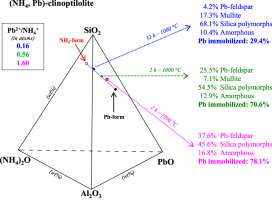Microporous and Mesoporous Materials ( IF 5.2 ) Pub Date : 2018-03-22 , DOI: 10.1016/j.micromeso.2018.03.026 Antonio Brundu , Eleonora Sale , Guido Cerri

|
Three clinoptilolite-based materials, having Pb2+/NH4+ ratios of 1.60, 0.56 and 0.16, were prepared starting from a powder containing ≈90% of NH4-clinoptilolite. The samples were submitted to a set of thermal treatments of 2 h up to 1000 °C. Further treatments were performed at 900 and 1000 °C for 4, 8, 16 and 32 h. (NH4, Pb)-clinoptilolite underwent dehydration, de-ammoniation, and dehydroxylation, the latter accompanied by amorphization that occurred between 600 and 700 °C, whereas crystallization of new phases started at 800–900 °C. The products, obtained through solid state reactions, were: i) Pb-feldspar + cristobalite/tridymite + glass, when Pb2+/NH4+ ≥ 0.16; ii) mullite + cristobalite/tridymite + glass, when 0 ≤ Pb2+/NH4+ ≤ 1.60, hence both Pb-feldspar and mullite were obtained for 0.16 ≤ Pb2+/NH4+ ≤ 1.60. XRD data showed that, for a given composition, temperature and duration of the heating influenced the quantity of the phases formed, but also the occupancy of Pb- and T-sites of Pb-feldspar. Crystalline products (amorphous 10–12%) were obtained from all samples. When Pb2+/NH4+ ≥ 0.56, the highest amounts of Pb-feldspar and the lowest quantities of residual glass were recorded after 32 h at 900 °C, but a 2-h treatment at 1000 °C allowed to speed up the transformation, confining over 70% of lead within feldspar. The sample with Pb2+/NH4+ = 0.16 required 32 h at 1000 °C to reduce glass at 10%, but most of the lead (≈70%) remained in the amorphous fraction.
中文翻译:

(NH 4,Pb)-斜发沸石通过加热的固态转变
从含≈90%NH 4-斜发沸石的粉末开始,制备三种Pb 2+ / NH 4 +比为1.60、0.56和0.16的斜发沸石基材料。样品经过2 h最高1000°C的热处理。在900和1000°C下进行了4、8、16和32小时的进一步处理。(NH 4,Pb)-斜发沸石经历了脱水,脱氨和脱羟基作用,后者伴随着600至700°C的非晶化,而新相的结晶则始于800-900°C。通过固态反应获得的产物为:i)Pb 2+ / NH 4 +时,Pb长石+方石英/鳞石英+玻璃≥0.16; ⅱ)莫来石+方石英/鳞石英+玻璃,当0≤铅2+ / NH 4 + ≤1.60,因此两者的Pb-长石和莫来石为0.16≤铅获得2+ / NH 4 + ≤1.60。XRD数据表明,对于给定的组成,加热的温度和持续时间会影响所形成的相的数量,但也会影响Pb-长石的Pb-和T-位的占有率。从所有样品中均获得结晶产物(非晶态10–12%)。当Pb 2+ / NH 4 +≥0.56时,在900°C下放置32 h后,记录到的Pb长石含量最高,而残留玻璃量最低,但是在1000°C下进行2 h处理可以加速转化,将铅限制在70%以上在长石内。Pb 2+ / NH 4 + = 0.16的样品在1000°C下需要32 h才能还原10%的玻璃,但是大多数铅(≈70%)保留在非晶态部分中。


























 京公网安备 11010802027423号
京公网安备 11010802027423号